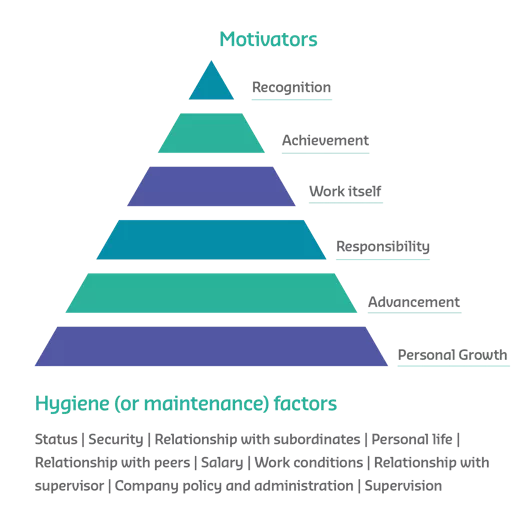
Harness the power of motivation with Maslow, Herzberg, and Pink
2 December 2021
Employee motivation is vital to your success, as it's the drive and energy your employees bring to their work every day. Motivated employees are more engaged, innovative, and happier, boosting productivity and helping your business to thrive. Read on to discover how to get the best from your people.
Experts like Maslow, Herzberg, McGuire, Winslow, McKellend, and Drucker have changed how we engage and inspire our teams.
Understanding theories of motivation = higher employee engagement, satisfaction, and motivation.
Of the psychologists listed above, Maslow, Herzberg, and Pink’s theories are the most renowned and have become the ‘go-to’ theories for employers seeking to enhance their company culture.
Exploring Maslow’s Hierarchy of Needs
Psychologist, Abraham Maslow, first introduced his concept of a hierarchy of needs in his 1943 paper A Theory of Human Motivation and his subsequent book Motivation and Personality. Maslow’s theory suggests that before striving to increase employee motivation, passion, and engagement, we must ensure that we're meeting their basic needs.
Maslow refers to these needs as ‘hygiene factors’, which include relationships with colleagues, workplace conditions and company values and practices.
How successful do you think your efforts to motivate an employee to be more productive will be if they’re experiencing conflicts at work?
Prioritise the hygiene factors to create a solid base to work from.
Maslow’s Hierarchy of Needs continues with this theme. Most often depicted as a pyramid where the lower, more basic needs must be met before moving on to the next level.
Consider your employee development plans… advancement comes from personal growth. With advancement comes more responsibility. Next, the role and work itself will change, leading to a sense of achievement. Finally, we have the most crucial stage in motivating your people – recognising and rewarding their achievements.

It’s essential to map progression and work through each step of the pyramid. Maslow’s research states that once an employee achieves a level, it no longer has strength as a motivator.
Every person is capable of and desires to move up the hierarchy toward a level of self-actualisation, but Maslow found that only one in 100 achieve it. Your employees are unique, as are their paths, and the hygiene factors can impact their ability to move up the hierarchy and achieve self-actualisation.
Personal life and salary are hygiene factors, and they’re not consistent. We’re experiencing a cost-living crisis, and salaries aren’t stretching as far as they once did, disrupting what could have once been a satisfied hygiene factor.
Continuous review + honest communication = hygiene factors met.
Herzberg’s Motivation & Hygiene Factors
Herzberg took research into the concept of hygiene factors further, discovering that satisfaction and dissatisfaction at work nearly always arose from different factors and were not simply opposing reactions to the same factors, as had always previously been believed.
Like Maslow, Herzberg agrees that the hygiene factors form the base and must be satisfied for motivational efforts to be successful. However, Herzberg proved that these hygiene factors or needs were more fundamental than that, intrinsically linked to our happiness.
Hygiene factors are the base at the bottom of the pyramid. Alone, they don’t motivate. When satisfied, they hold the pyramid up; when damaged, things become unstable or, in the case of motivating your people – ineffective.
Frederick Herzberg’s book The Motivation to Work, written with research colleagues Bernard Mausner and Barbara Bloch Snyderman in 1959, first established his theories about motivation in the workplace.
Herzberg’s survey work on 200 Pittsburgh engineers and accountants remains a fundamentally important reference in motivational studies. While the study involved only 200 people, Herzberg’s considerable preparatory investigations and research design enabled Herzberg and his colleagues to gather and analyse a highly sophisticated level of data.

Pink’s Theory of Motivation
Motivational author, Daniel Pink, released his New York Bestseller, Drive, in 2010, arguing that the carrot and stick approach is no longer relevant for today’s workforce.
Thirty years of research + exploring business wants & needs = Pink’s simple, modern, and effective approach, tailored to suit different organisational needs.
Published in his book, Drive, Pink details three elements of true motivation:
Autonomy
Autonomy = freedom from external control and independence.
No employee has 100% autonomy. KPIs need to be met, and company values must be practised. We all answer to someone – no matter our seniority. Still, employees need some sense of autonomy in their roles to be motivated, and here are a few ways they can apply it:
1) Time – allow employees to manage it.
Flexible working is becoming the norm, with employers understanding the need for a work-life balance. Some tasks will be time-sensitive – it’s the nature of business - but it won’t be the case for every item on your employees’ to-do lists.
Flexible approach to time management = a sense of autonomy and increased motivation.
2) Technique – encourage creativity and individuality.
Your employees think, learn, and work differently, so we shouldn’t dictate how to complete a project or task. Share guidance, benchmarks, and need-to-knows whilst empowering employees with autonomy regarding how they achieve the goal.
Micromanagement + strict procedures = lack of autonomy and motivation.
3) Team – embracing the idea of choice.
Workplaces have departmental structures, and teams exist in specific areas. However, there are times when projects arise that require cross-departmental collaboration. This third principle of autonomy encourages managers to allow their project leads to build their teams based on who they feel they work best with.
Trust + autonomy = increased motivation to succeed
4) Task – mix it up!
Employees and teams have specific roles and responsibilities, but they don’t have to be set in stone. Schedule regular creativity days, encouraging your workforce to tackle a problem or offer ideas for areas of your business they don’t usually work in.
Evidence shows that many new initiatives are generated through creative free time, and different perspectives are beneficial. It’s also an impactful way to get people out of siloes and feel valued within the business.
Creative input + a fresh pair of eyes = creative problem-solving.
Mastery
Helping your employees become ‘masters of their trade’ through continuous learning and development opens up a world of opportunities for your business and improves employee retention rates.
Four essentials to fostering an environment of learning and development:
1. Autonomy
2. Clear goals
3. Immediate feedback
4. 'Goldilocks' tasks - not too difficult and not too simple
Purpose
Employees are seeking purpose-driven, socially responsible employers.
56% of employees would consider changing jobs with no salary increase if the opportunity was with a company with an excellent reputation.
Give purpose as much importance as profit because that’s where your reputation is formed. Success and profitability may be a selling point, but how your business conducted itself to get there will be a point of focus. Your social value pledge defines who you are as a business, creating a culture in which your employees are proud to be involved.
Unleash your potential with Pluxee UK
We can agree that there’s more to employee motivation than offering a reward, with the three theories we’ve explored here breaking the concept of motivation into basic human needs.
Hygiene factors are the crux – deciding the fate of your employee motivation strategy.
Your employees’ physical, mental, and financial wellbeing sit within this base – these basic needs – so this is where you should start.
Boost mental resilience with our Employee Assistance Programme and help employees prioritise their bodies with Online GP or our Gym & Fitness Discounts. Alleviate the burden of the rising cost of living with salary-stretching solutions, including our Pluxee Card and Employee Benefits Platform.
Are you ready to reap the benefits of a highly motivated workforce?
Arrange a call today to discover how Pluxee UK can help you build a sustainable and impactful employee wellbeing strategy. Together, let’s open up a world of opportunities for your people to enjoy more of what really matters in their lives.





